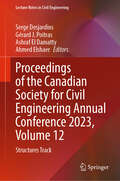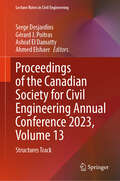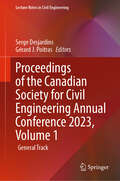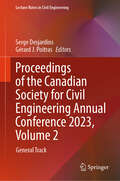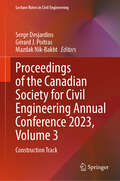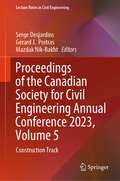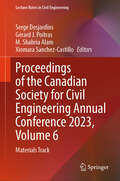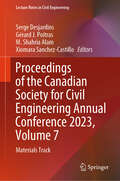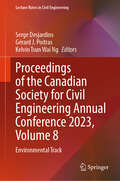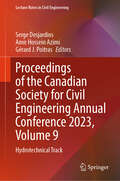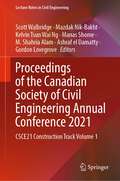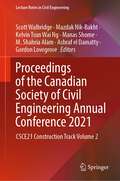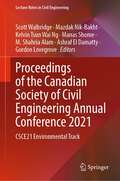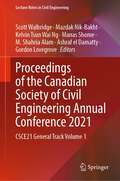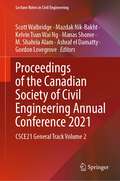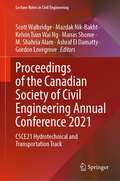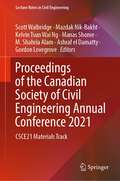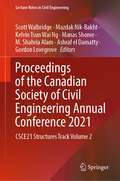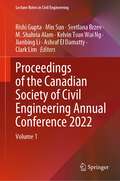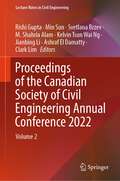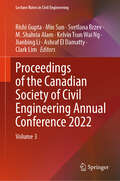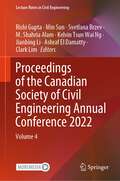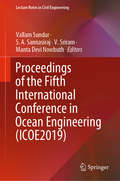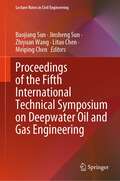- Table View
- List View
Proceedings of the Canadian Society for Civil Engineering Annual Conference 2023, Volume 12: Structures Track (Lecture Notes in Civil Engineering #506)
by Ashraf El Damatty Serge Desjardins Gérard J. Poitras Ahmed ElshaerThis book comprises the proceedings of the Annual Conference of the Canadian Society for Civil Engineering 2023. The contents of this volume focus on the specialty track in structural engineering with topics on bridge design, FRP concrete structures, innovation in structural engineering, seismic analysis and design, wind load on structures, masonry structures, structural optimization, machine learning and AI in structural engineering, and wood and timber structures, among others. This volume will prove a valuable resource for researchers and professionals.
Proceedings of the Canadian Society for Civil Engineering Annual Conference 2023, Volume 13: Structures Track (Lecture Notes in Civil Engineering #507)
by Ashraf El Damatty Serge Desjardins Gérard J. Poitras Ahmed ElshaerThis book comprises the proceedings of the Annual Conference of the Canadian Society for Civil Engineering 2023. The contents of this volume focus on the specialty track in structural engineering with topics on bridge design, FRP concrete structures, innovation in structural engineering, seismic analysis and design, wind load on structures, masonry structures, structural optimization, machine learning and AI in structural engineering, and wood and timber structures, among others. This volume will prove a valuable resource for researchers and professionals.
Proceedings of the Canadian Society for Civil Engineering Annual Conference 2023, Volume 1: General Track (Lecture Notes in Civil Engineering #495)
by Serge Desjardins Gérard J. PoitrasThis book comprises the proceedings of the Annual Conference of the Canadian Society for Civil Engineering 2023. The contents of this volume focus on the general conference with topics on transportation, climate adaptability, sustainable design, green buildings, cold regions, and civil engineering education, among others. This volume will prove a valuable resource for researchers and professionals.
Proceedings of the Canadian Society for Civil Engineering Annual Conference 2023, Volume 2: General Track (Lecture Notes in Civil Engineering #496)
by Serge Desjardins Gérard J. PoitrasThis book comprises the proceedings of the Annual Conference of the Canadian Society for Civil Engineering 2023. The contents of this volume focus on the general conference with topics on transportation, climate adaptability, sustainable design, green buildings, cold regions, and civil engineering education, among others. This volume will prove a valuable resource for researchers and professionals.
Proceedings of the Canadian Society for Civil Engineering Annual Conference 2023, Volume 3: Construction Track (Lecture Notes in Civil Engineering #497)
by Mazdak Nik-Bakht Serge Desjardins Gérard J. PoitrasThis book comprises the proceedings of the Annual Conference of the Canadian Society for Civil Engineering 2023. The contents of this volume focus on the specialty track in construction with topics on modular and offsite construction, BIM, construction planning and project management, construction automation, AI and robotics in construction, sustainable construction, asset management, and construction safety, among others. This volume will prove a valuable resource for researchers and professionals.
Proceedings of the Canadian Society for Civil Engineering Annual Conference 2023, Volume 4: Construction Track (Lecture Notes in Civil Engineering #498)
by Mazdak Nik-Bakht Serge Desjardins Gérard J. PoitrasThis book comprises the proceedings of the Annual Conference of the Canadian Society for Civil Engineering 2023. The contents of this volume focus on the specialty track in construction with topics on modular and offsite construction, BIM, construction planning and project management, construction automation, AI and robotics in construction, sustainable construction, asset management, and construction safety, among others. This volume will prove a valuable resource for researchers and professionals.
Proceedings of the Canadian Society for Civil Engineering Annual Conference 2023, Volume 5: Construction Track (Lecture Notes in Civil Engineering #499)
by Mazdak Nik-Bakht Serge Desjardins Gérard J. PoitrasThis book comprises the proceedings of the Annual Conference of the Canadian Society for Civil Engineering 2023. The contents of this volume focus on the specialty track in construction with topics on modular and offsite construction, BIM, construction planning and project management, construction automation, AI and robotics in construction, sustainable construction, asset management, and construction safety, among others. This volume will prove a valuable resource for researchers and professionals.
Proceedings of the Canadian Society for Civil Engineering Annual Conference 2023, Volume 6: Materials Track (Lecture Notes in Civil Engineering #500)
by M. Shahria Alam Serge Desjardins Gérard J. Poitras Xiomara Sanchez-CastilloThis book comprises the proceedings of the Annual Conference of the Canadian Society for Civil Engineering 2023. The contents of this volume focus on the specialty track in materials with topics on recycled materials, concrete durability, geopolymers, alkali-activated and other alternative binders, fiber-reinforced and engineered cementitious composites, advanced composite materials, ultra-high-performance materials, and innovative and emerging materials, among others. This volume will prove a valuable resource for researchers and professionals.
Proceedings of the Canadian Society for Civil Engineering Annual Conference 2023, Volume 7: Materials Track (Lecture Notes in Civil Engineering #501)
by M. Shahria Alam Serge Desjardins Gérard J. Poitras Xiomara Sanchez-CastilloThis book comprises the proceedings of the Annual Conference of the Canadian Society for Civil Engineering 2023. The contents of this volume focus on the specialty track in materials with topics on recycled materials, concrete durability, geopolymers, alkali-activated and other alternative binders, fiber-reinforced and engineered cementitious composites, advanced composite materials, ultra-high-performance materials, and innovative and emerging materials, among others. This volume will prove a valuable resource for researchers and professionals.
Proceedings of the Canadian Society for Civil Engineering Annual Conference 2023, Volume 8: Environmental Track (Lecture Notes in Civil Engineering #502)
by Kelvin Tsun Wai Ng Serge Desjardins Gérard J. PoitrasThis book comprises the proceedings of the Annual Conference of the Canadian Society for Civil Engineering 2023. The contents of this volume focus on the specialty track in environmental engineering with topics on water and wastewater treatment, sustainability and climate change, remediation, and environmental hazards, among others. This volume will prove a valuable resource for researchers and professionals.
Proceedings of the Canadian Society for Civil Engineering Annual Conference 2023, Volume 9: Hydrotechnical Track (Lecture Notes in Civil Engineering #503)
by Serge Desjardins Gérard J. Poitras Amir Hossein AzimiThis book comprises the proceedings of the Annual Conference of the Canadian Society for Civil Engineering 2023. The contents of this volume focus on the specialty track in hydrotechnical engineering with topics on hydraulic structures, river engineering, water management, hydrology and machine learning, fluvial hydraulics, and sediment transport, among others. This volume will prove a valuable resource for researchers and professionals.
Proceedings of the Canadian Society of Civil Engineering Annual Conference 2021: CSCE21 Construction Track Volume 1 (Lecture Notes in Civil Engineering #251)
by Scott Walbridge Mazdak Nik-Bakht Kelvin Tsun Wai Ng Manas Shome M. Shahria Alam Ashraf El Damatty Gordon LovegroveThis book comprises the proceedings of the Annual Conference of the Canadian Society of Civil Engineering 2021. The contents of this volume focus on specialty conferences in construction, environmental, hydrotechnical, materials, structures, transportation engineering, etc. This volume will prove a valuable resource for those in academia and industry.
Proceedings of the Canadian Society of Civil Engineering Annual Conference 2021: CSCE21 Construction Track Volume 2 (Lecture Notes in Civil Engineering #247)
by Scott Walbridge Mazdak Nik-Bakht Kelvin Tsun Wai Ng Manas Shome M. Shahria Alam Ashraf El Damatty Gordon LovegroveThis book comprises the proceedings of the Annual Conference of the Canadian Society of Civil Engineering 2021. The contents of this volume focus on specialty conferences in construction, environmental, hydrotechnical, materials, structures, transportation engineering, etc. This volume will prove a valuable resource for those in academia and industry.
Proceedings of the Canadian Society of Civil Engineering Annual Conference 2021: CSCE21 Environmental Track (Lecture Notes in Civil Engineering #249)
by Scott Walbridge Mazdak Nik-Bakht Kelvin Tsun Wai Ng Manas Shome M. Shahria Alam Ashraf El Damatty Gordon LovegroveThis book comprises the proceedings of the Annual Conference of the Canadian Society of Civil Engineering 2021. The contents of this volume focus on specialty conferences in construction, environmental, hydrotechnical, materials, structures, transportation engineering, etc. This volume will prove a valuable resource for those in academia and industry.
Proceedings of the Canadian Society of Civil Engineering Annual Conference 2021: CSCE21 General Track Volume 1 (Lecture Notes in Civil Engineering #239)
by Scott Walbridge Mazdak Nik-Bakht Kelvin Tsun Wai Ng Manas Shome M. Shahria Alam Ashraf El Damatty Gordon LovegroveThis book comprises the proceedings of the Annual Conference of the Canadian Society of Civil Engineering 2021. The contents of this volume focus on specialty conferences in construction, environmental, hydrotechnical, materials, structures, transportation engineering, etc. This volume will prove a valuable resource for those in academia and industry.
Proceedings of the Canadian Society of Civil Engineering Annual Conference 2021: CSCE21 General Track Volume 2 (Lecture Notes in Civil Engineering #240)
by Scott Walbridge Mazdak Nik-Bakht Kelvin Tsun Wai Ng Manas Shome M. Shahria Alam Ashraf El Damatty Gordon LovegroveThis book comprises the proceedings of the Annual Conference of the Canadian Society of Civil Engineering 2021. The contents of this volume focus on specialty conferences in construction, environmental, hydrotechnical, materials, structures, transportation engineering, etc. This volume will prove a valuable resource for those in academia and industry.
Proceedings of the Canadian Society of Civil Engineering Annual Conference 2021: CSCE21 Hydrotechnical and Transportation Track (Lecture Notes in Civil Engineering #250)
by Scott Walbridge Mazdak Nik-Bakht Kelvin Tsun Wai Ng Manas Shome M. Shahria Alam Ashraf El Damatty Gordon LovegroveThis book comprises the proceedings of the Annual Conference of the Canadian Society of Civil Engineering 2021. The contents of this volume focus on specialty conferences in construction, environmental, hydrotechnical, materials, structures, transportation engineering, etc. This volume will prove a valuable resource for those in academia and industry.
Proceedings of the Canadian Society of Civil Engineering Annual Conference 2021: CSCE21 Materials Track (Lecture Notes in Civil Engineering #248)
by Scott Walbridge Mazdak Nik-Bakht Kelvin Tsun Wai Ng Manas Shome M. Shahria Alam Ashraf El Damatty Gordon LovegroveThis book comprises the proceedings of the Annual Conference of the Canadian Society of Civil Engineering 2021. The contents of this volume focus on specialty conferences in construction, environmental, hydrotechnical, materials, structures, transportation engineering, etc. This volume will prove a valuable resource for those in academia and industry.
Proceedings of the Canadian Society of Civil Engineering Annual Conference 2021: CSCE21 Structures Track Volume 2 (Lecture Notes in Civil Engineering #244)
by Scott Walbridge Mazdak Nik-Bakht Kelvin Tsun Wai Ng Manas Shome M. Shahria Alam Ashraf El Damatty Gordon LovegroveThis book comprises the proceedings of the Annual Conference of the Canadian Society of Civil Engineering 2021. The contents of this volume focus on specialty conferences in construction, environmental, hydrotechnical, materials, structures, transportation engineering, etc. This volume will prove a valuable resource for those in academia and industry.
Proceedings of the Canadian Society of Civil Engineering Annual Conference 2022: Volume 1 (Lecture Notes in Civil Engineering #363)
by Rishi Gupta Kelvin Tsun Wai Ng M. Shahria Alam Ashraf El Damatty Min Sun Svetlana Brzev Jianbing Li Clark LimThis book comprises the proceedings of the Annual Conference of the Canadian Society of Civil Engineering 2022. The contents of this volume focus on specialty conferences in construction, environmental, hydrotechnical, materials, structures, transportation engineering, etc. This volume will prove a valuable resource for those in academia and industry.
Proceedings of the Canadian Society of Civil Engineering Annual Conference 2022: Volume 2 (Lecture Notes in Civil Engineering #348)
by Rishi Gupta Kelvin Tsun Wai Ng M. Shahria Alam Ashraf El Damatty Min Sun Svetlana Brzev Jianbing Li Clark LimThis book comprises the proceedings of the Annual Conference of the Canadian Society of Civil Engineering 2022. The contents of this volume focus on specialty conferences in construction, environmental, hydrotechnical, materials, structures, transportation engineering, etc. This volume will prove a valuable resource for those in academia and industry.
Proceedings of the Canadian Society of Civil Engineering Annual Conference 2022: Volume 3 (Lecture Notes in Civil Engineering #359)
by Rishi Gupta Kelvin Tsun Wai Ng M. Shahria Alam Ashraf El Damatty Min Sun Svetlana Brzev Jianbing Li Clark LimThis book comprises the proceedings of the Annual Conference of the Canadian Society of Civil Engineering 2022. The contents of this volume focus on specialty conferences in construction, environmental, hydrotechnical, materials, structures, transportation engineering, etc. This volume will prove a valuable resource for those in academia and industry.
Proceedings of the Canadian Society of Civil Engineering Annual Conference 2022: Volume 4 (Lecture Notes in Civil Engineering #367)
by Rishi Gupta Kelvin Tsun Wai Ng M. Shahria Alam Ashraf El Damatty Min Sun Svetlana Brzev Jianbing Li Clark LimThis book comprises the proceedings of the Annual Conference of the Canadian Society of Civil Engineering 2022. The contents of this volume focus on specialty conferences in construction, environmental, hydrotechnical, materials, structures, transportation engineering, etc. This volume will prove a valuable resource for those in academia and industry.
Proceedings of the Fifth International Conference in Ocean Engineering (Lecture Notes in Civil Engineering #106)
by V. Sriram Vallam Sundar S. A. Sannasiraj Manta Devi NowbuthThis book comprises the proceedings of the Fifth International Conference in Ocean Engineering (ICOE2019) focusing on emerging opportunities and challenges in the field of ocean engineering and offshore structures. Some of the themes covered in this volume are offshore structures and deepwater technology, ocean optics & acoustics, ocean renewable energy, marine spatial planning, climate change impacts & disaster risk reduction, etc. The essays are written by leading international experts, making it a valuable resource for researchers and practicing engineers alike.
Proceedings of the Fifth International Technical Symposium on Deepwater Oil and Gas Engineering (Lecture Notes in Civil Engineering #472)
by Baojiang Sun Zhiyuan Wang Jinsheng Sun Litao Chen Meiping ChenThis book is a compilation of selected papers from the Fifth International Technical Symposium on Deepwater Oil and Gas Engineering and the Fourth International Youth Forum on Gas Hydrate (DWOG-Hyd 2023), held in Qingdao, China, in October 2023. The book focuses on the advancement of techniques for the deepwater oil and gas exploitation and natural gas hydrate exploitation. The book introduces new ideas for exploring deepwater oil, gas and hydrate in a safe and efficient way. Advances of the deepwater oil, gas and hydrate drilling and production in South China Sea, in oil and gas flow assurance and emerging technologies based on clathrate hydrate will be presented. It is a valuable resource for both practitioners and academics working in the field of deepwater oil and gas engineering.
